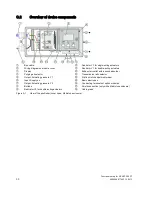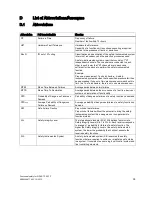
Functional safety for SIPART PS2 FF
22
A5E00489774-02, 10/2013
The "average probability of dangerous failures of the entire safety-instrumented system" (PFD
AVG
) is normally split between
the following three components:
Figure 2-2
PFD distribution
The following table shows the achievable Safety Integrity Level (SIL) for the entire safety-instrumented system for type A
devices depending on the safe failure fraction (SFF) and the hardware fault tolerance (HFT).
●
Type A devices include analog transmitters and shut-off valves without complex components, e.g. microprocessors (see
also IEC 61508, Section 2).
●
The specific values for your device are listed in the manufacturer's declaration (Declaration of Conformity, Functional
Safety according to IEC 61508 and IEC 61511): Certificates
(
http://www.siemens.com/processinstrumentation/certificates
).
SFF
HFT for type A devices
0
1
2
< 60 %
SIL 1
SIL 2
SIL 3
60 to 90 %
SIL 2
SIL 3
SIL 4
90 to 99 %
SIL 3
SIL 4
SIL 4
> 99 %
SIL 3
SIL 4
SIL 4
2.4
Settings
WARNING
Safety function: Positioning "Jumper" on the basic electronics
The safety function is not activated in the delivered state; the "Jumper" is in the "Normal" position. "Normal" means:
Without safety function, no depressurizing of the connected actuator. To activate the safety function, proceed as follows:
●
Insert the "Jumper" in the left position facing the terminals. This corresponds to the position "Shut Down enabled" on
the wiring diagram present on the module cover, see "Figure A-1 View of the positioner (cover open; Makrolon
enclosure) (Page 30)".
Or
●
Remove the "Jumper" from the basic electronics.
Special parameter settings are not necessary.
Protection against configuration changes
You should attach the housing cover so that the device is protected against unwanted and unauthorized changes/operation.
Checking the safety function
Prerequisite for checking the safety function
●
Positioner is in operation.
●
The actuator belonging to the positioner is not in the safety position.
Procedure
1.
In order to test the safety shutdown, apply a LOW level, i.e. a voltage of maximum 4.5 V, to the input for the safety
shutdown.
2.
Verify that the valve returns to the safety position.
3.
In order to test the response of the actuator, apply a HIGH level, i.e. a voltage >13 V, to the input for the safety
shutdown.

































